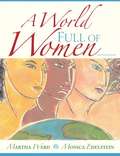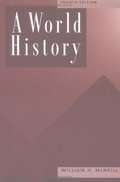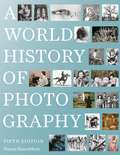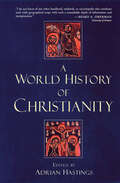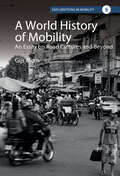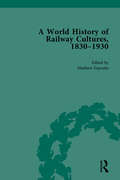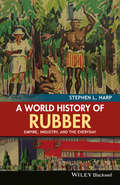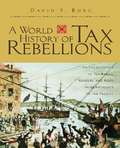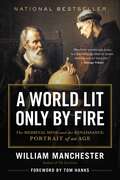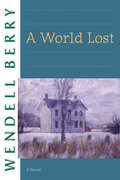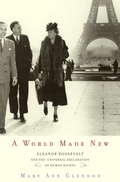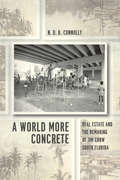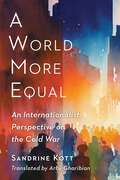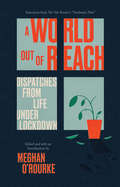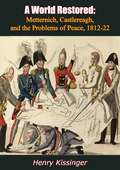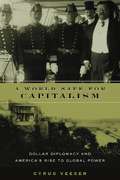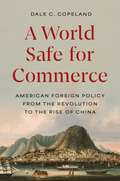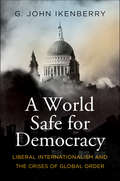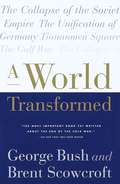- Table View
- List View
A World Full of Strangers: A Saga of Love & Retribution
by Cynthia FreemanA multigenerational saga of an immigrant Jewish family in America—from Hester Street to San Francisco—by a New York Times–bestselling author. Katie Kovitz is seventeen years old when her mother dies. Leaving London for New York Harbor during the bitter winter of 1932, the anxious and uncertain young girl relies on the kindness of strangers for refuge. Welcomed into the home of her Polish mother&’s closest childhood friend, Katie is embraced by her new family in a country warm with hope and opportunity. There, on Hester Street in the Jewish ghetto of the city&’s Lower East Side, Katie finally establishes the roots that will come to define her. In New York, Katie also finds her future in three people who will change her life in ways she never anticipated: David, the man she marries, a ruthless achiever willing to abandon his heritage to secure power and prosperity under a new name; Mark, their resolute and devout son, and the embodiment of everything his father hates and rejects; and Maggie, a San Francisco beauty who helps to mold David into the man he&’s always wanted to be, whatever the cost. As dreams and desires collide, and as Katie strives to reclaim her own lost identity, a series of events will forever affect the ambitions, promises, and legacies of an American family. From the prewar ghettos of Manhattan to the glittering hills of postwar San Francisco, author Cynthia Freeman follows the destinies of three generations of a resilient family, their intimate struggles, and personal triumphs, and brings to vivid life the soul and spirit of the extraordinary Jewish immigrant experience in America.
A World Full of Women (5th edition)
by Martha Ward Monica EdelsteinWelcome to a world full of women. This book has two goals: to explore and validate woman-centered experiences, and to illuminate the common grounds of being female on Planet Earth.
A World History
by William H. McNeillGlobal in scope, William McNeill's widely acclaimed one-volume history emphasizes the four Old World civilizations of the Middle East, India, China, and Europe, paying particular attention to their interaction across time as well as the impact on historical scholarship in light of the most recent archaeological discoveries. The engaging and informative narrative touches on all aspects of civilization, including geography, communication, and technological and artistic developments, and provides extensive coverage of the modern era. This new edition includes a thoroughly updated bibliographic essay and a new discussion of the most significant events in world history and civilization since 1976.
A World History Of Photography
by Naomi Rosenblum Diana StollAn up-to-date edition of the authoritative history of photography—widely embraced by both students and general readers Naomi Rosenblum's classic history of photography traces the evolution of this young art form chronologically and thematically. Exploring the diverse roles that photography has played in the communication of ideas, Rosenblum devotes special attention to topics such as portraiture, documentation, advertising, and photojournalism, and to the camera as a means of personal artistic expression. Her text is illustrated with nearly nine hundred images by photographers both celebrated and little known, arranged in stimulating juxtapositions that illuminate their visual power. This fifth edition of A World History of Photography is substantively revised and updated. The photography of the past several decades is reevaluated from a contemporary perspective, and international developments are covered in greater detail. The main strands of today's complex universe of digital image-making are masterfully summarized and placed in their historical context, and the careers of representative contemporary photographers are studied in depth. Thoughtfully written, carefully and abundantly illustrated, and provided with a full apparatus—including a chronology, glossary, and annotated bibliography—Rosenblum's volume remains the indispensable work on its subject.
A World History of Ancient Political Thought: Its Significance and Consequences
by Antony BlackThis book examines the political thought of China, Greece, Israel, Rome, India, Iran, Egypt, Mesopotamia, and also early Christianity, from prehistory to c. 200 CE. Each of these had its priorities, based on a religious and philosophical perspective. This led to different ideas about who should govern, how to govern, and what government was for. In most cultures, sacred monarchy was the norm, but this ranged from absolute to conditional authority. 'The people' were recipients of royal (and divine) beneficence. Justice, the rule of law, and meritocracy were generally regarded as fundamental. In Greece and Rome, democracy and liberty were born, while in Israel the polity was based on covenant and the law. Confucius taught humaneness, Mozi and Christianity taught universal love; Kautilya and the Chinese 'Legalists' believed in realpolitik and an authoritarian state. <p><p>The conflict between might and right was resolved in many different ways. Chinese, Greek and Indian thinkers reflected on the origin and purposes of the state. Status and class were embedded in Indian and Chinese thought, the nation in Israelite thought. On the other hand, the Stoics and Cicero saw humanity as a single unit. Political philosophy, using logic, evidence and dialectic, was invented in China and Greece, statecraft in China and India, political science in Greece. Plato and Aristotle, followed by Polybius and Cicero, started 'western' political philosophy. This book covers political philosophy, religious ideology, constitutional theory, social ethics, official and popular political culture.
A World History of Christianity
by A World History of ChristianityChristianity is the most global of religions. However, most books on the subject fail to do justice to the history of Christianity outside Europe and North America. This prodigious work provides the first genuinely global one-volume study of the rise, development, and impact of the Christian faith. Written by an international team of specialists, this comprehensive volume covers the full breadth of Christian history while also taking seriously the geographical diversity of the story: extensive chapters cover North America, Latin America, Europe, Africa, India, China and its neighbors, and Australia and the Pacific. Though unified in scope, these chapters each focus on what matters most in the specific time and place covered, ensuring that readers are introduced to the major themes—social, theological, political, and cultural—that together constitute Christianity's role in world history. Ideally suited for classroom study as well as for independent reading, A World History of Christianity will serve as the definitive study of church history for the coming generation worldwide. Contributors: Mary B. Cunningham Gillian Evans Robert E. Frykenberg Martin Goodman Adrian Hastings Mary Heimann David Hilliard Robert Bruce Mullin Andrew Pettegree Gary Tiedemann Philip Walters Benedicta Ward Kevin Ward
A World History of Mobility: An Essay on Road Cultures and Beyond (Explorations in Mobility)
by Gijs Mom MomAs a tool of globalized mobility, the car provides a useful barometer for charting the global development of socio-cultural, economic, technical, and political modernization. Shaped by prevailing gender and racial norms and popularized by a Western-driven car culture, it is a commodity whose access and use embodies wider inequalities. In this comprehensive world history of (auto)mobility, Gijs Mom draws upon his extensive research into the field to assess the past and present of road cultures, and hypothesize their future. Ranging from the impact of climate change to decolonization, this volume spotlights how profoundly ‘automobilism’ impacts our sense of identity and imagination.
A World History of Railway Cultures, 1830-1930: Volume I
by Matthew EspositoThis 4-volume collection is the first compilation of primary sources to historicize the cultural impact of railways on a global scale from their inception in Great Britain to the Great Depression. Gathered together are over 200 rare out-of-print published and unpublished materials from archival and digital repositories throughout the world. Organized by historical geography, this first volume covers the United Kingdom.
A World History of Railway Cultures, 1830-1930: Volume II
by Matthew EspositoThis 4-volume collection is the first compilation of primary sources to historicize the cultural impact of railways on a global scale from their inception in Great Britain to the Great Depression. Gathered together are over 200 rare out-of-print published and unpublished materials from archival and digital repositories throughout the world. Organized by historical geography, the second volume spans the British Empire.
A World History of Railway Cultures, 1830-1930: Volume III
by Matthew EspositoThis 4-volume collection is the first compilation of primary sources to historicize the cultural impact of railways on a global scale from their inception in Great Britain to the Great Depression. Gathered together are over 200 rare out-of-print published and unpublished materials from archival and digital repositories throughout the world. Organized by historical geography, this third volume explores the railways through Eurasia.
A World History of Railway Cultures, 1830-1930: Volume IV
by Matthew EspositoThis 4-volume collection is the first compilation of primary sources to historicize the cultural impact of railways on a global scale from their inception in Great Britain to the Great Depression. Gathered together are over 200 rare out-of-print published and unpublished materials from archival and digital repositories throughout the world. Organized by historical geography, volume 4 considers the Americas
A World History of Rubber: Empire, Industry, and the Everyday
by Stephen L. HarpA World History of Rubber helps readers understand and gain new insights into the social and cultural contexts of global production and consumption, from the nineteenth century to today, through the fascinating story of one commodity. Divides the coverage into themes of race, migration, and labor; gender on plantations and in factories; demand and everyday consumption; World Wars and nationalism; and resistance and independence Highlights the interrelatedness of our world long before the age of globalization and the global social inequalities that persist today Discusses key concepts of the nineteenth and twentieth centuries, including imperialism, industrialization, racism, and inequality, through the lens of rubber Provides an engaging and accessible narrative for all levels that is filled with archival research, illustrations, and maps
A World History of Tax Rebellions: An Encyclopedia of Tax Rebels, Revolts, and Riots from Antiquity to the Present
by David F. BurgA World History of Tax Rebellions is an exhaustive reference source for over 4,300 years of riots, rebellions, protests, and war triggered by abusive taxation and tax collecting systems around the world. Each of the chronologically arranged entries focuses on a specific historical event, analyzing its roots, and socio-economic context.
A World Lit Only by Fire: The Medieval Mind and the Renaissance - Portrait of an Age
by William ManchesterA "lively and engaging" history of the Middle Ages (Dallas Morning News) from the acclaimed historian William Manchester, author of The Last Lion. From tales of chivalrous knights to the barbarity of trial by ordeal, no era has been a greater source of awe, horror, and wonder than the Middle Ages. In handsomely crafted prose, and with the grace and authority of his extraordinary gift for narrative history, William Manchester leads us from a civilization tottering on the brink of collapse to the grandeur of its rebirth: the dense explosion of energy that spawned some of history's greatest poets, philosophers, painters, adventurers, and reformers, as well as some of its most spectacular villains."Manchester provides easy access to a fascinating age when our modern mentality was just being born." --Chicago Tribune
A World Lost: A Novel (Port William Ser.)
by Wendell BerrySet against the turmoil of the World War II, A World Lost is just one of the classic chapters in Berry's Port William series. The summer of 1944 finds nine-year-old Andy Catlett in that very town in Kentucky, occupied more with watching meadowlarks and dipping into the nearby spring than with the weary news of the day. But when his Uncle Andrew is murdered, Andy confronts his own sense of culpability for the brawl that took his uncle's life. Told from Andy's perspective some 50 years later, the novel explores the gripping power of memory, even after decades have passed and asks each of us what in our own pasts we might have remedied.
A World Made New
by Mary Ann GlendonA World Made New tells the dramatic story of the struggle to build, out of the trauma and wreckage of World War II, a document that would ensure it would never happen again. There was an almost religious intensity to the project, championed by Eleanor Roosevelt under the aegis of the newly formed United nations and brought into being by an extraordinary group of men and women who knew, like the framers of the Declaration of Independence, that they were making history. They worked against the clock, the brief window between the end of World War II and the deep freeze of the cold war, to forget the founding document of the modern rights movement.A distinguished professor of international law, Mary Ann Glendon was given exclusive access to personal diaries and unpublished memoirs of key participants. An outstanding work of narrative history, A World Made New is the first book devoted to this crucial moment in Eleanor Roosevelt's life and in world history.
A World More Concrete: Real Estate and the Remaking of Jim Crow South Florida
by N. D. B. ConnollyMany people characterize urban renewal projects and the power of eminent domain as two of the most widely despised and often racist tools for reshaping American cities in the postwar period. In A World More Concrete, N. D. B. Connolly uses the history of South Florida to unearth an older and far more complex story. Connolly captures nearly eighty years of political and land transactions to reveal how real estate and redevelopment created and preserved metropolitan growth and racial peace under white supremacy. Using a materialist approach, he offers a long view of capitalism and the color line, following much of the money that made land taking and Jim Crow segregation profitable and preferred approaches to governing cities throughout the twentieth century. A World More Concrete argues that black and white landlords, entrepreneurs, and even liberal community leaders used tenements and repeated land dispossession to take advantage of the poor and generate remarkable wealth. Through a political culture built on real estate, South Florida's landlords and homeowners advanced property rights and white property rights, especially, at the expense of more inclusive visions of equality. For black people and many of their white allies, uses of eminent domain helped to harden class and color lines. Yet, for many reformers, confiscating certain kinds of real estate through eminent domain also promised to help improve housing conditions, to undermine the neighborhood influence of powerful slumlords, and to open new opportunities for suburban life for black Floridians. Concerned more with winners and losers than with heroes and villains, A World More Concrete offers a sober assessment of money and power in Jim Crow America. It shows how negotiations between powerful real estate interests on both sides of the color line gave racial segregation a remarkable capacity to evolve, revealing property owners' power to reshape American cities in ways that can still be seen and felt today.
A World More Concrete: Real Estate and the Remaking of Jim Crow South Florida (Historical Studies Of Urban America Ser.)
by N.D.B. ConnollyMany people characterize urban renewal projects and the power of eminent domain as two of the most widely despised and often racist tools for reshaping American cities in the postwar period. In A World More Concrete, N. D. B. Connolly uses the history of South Florida to unearth an older and far more complex story. Connolly captures nearly eighty years of political and land transactions to reveal how real estate and redevelopment created and preserved metropolitan growth and racial peace under white supremacy. Using a materialist approach, he offers a long view of capitalism and the color line, following much of the money that made land taking and Jim Crow segregation profitable and preferred approaches to governing cities throughout the twentieth century.A World More Concrete argues that black and white landlords, entrepreneurs, and even liberal community leaders used tenements and repeated land dispossession to take advantage of the poor and generate remarkable wealth. Through a political culture built on real estate, South Florida’s landlords and homeowners advanced property rights and white property rights, especially, at the expense of more inclusive visions of equality. For black people and many of their white allies, uses of eminent domain helped to harden class and color lines. Yet, for many reformers, confiscating certain kinds of real estate through eminent domain also promised to help improve housing conditions, to undermine the neighborhood influence of powerful slumlords, and to open new opportunities for suburban life for black Floridians. Concerned more with winners and losers than with heroes and villains, A World More Concrete offers a sober assessment of money and power in Jim Crow America. It shows how negotiations between powerful real estate interests on both sides of the color line gave racial segregation a remarkable capacity to evolve, revealing property owners’ power to reshape American cities in ways that can still be seen and felt today.
A World More Equal: An Internationalist Perspective on the Cold War (Columbia Studies in International and Global History)
by Sandrine KottThe post–World War II period is typically seen as a time of stark division, an epochal global conflict between the United States and the Soviet Union. But beneath the surface, the postwar era witnessed a striking degree of international cooperation. The United Nations and its agencies, as well as regional organizations, international nongovernmental organizations, and private foundations brought together actors from conflicting worlds, fostering international collaboration across the geopolitical and ideological divisions of the Cold War.Diving into the archives of these organizations and associations, Sandrine Kott provides a new account of the Cold War that foregrounds the rise of internationalism as both an ideology and a practice. She examines cooperation across boundaries in international spaces, emphasizing the role of midsized powers, including Eastern European and neutral countries. Kott highlights how the need to address global inequities became a central concern, as officials and experts argued that economic inequality imperiled the creation of a lasting peace. International organizations gave newly decolonized and “Third World” countries a platform to challenge the global distribution of power and wealth, and they encouraged transnational cooperation in causes such as human rights and women’s rights. Assessing the failure to achieve a new international economic order in the 1970s, Kott adds new perspective on the rise of neoliberalism. A truly global study of the Cold War through the lens of international organizations, A World More Equal also shows why the internationalism of this era offers resources for addressing social and global inequalities today.
A World Out of Reach: Dispatches from Life under Lockdown
by Meghan O’RourkeIn beautifully written and powerfully thought prose, A World Out of Reach offers a crucial record of COVID-19 and the cataclysmic spring of 2020—a record for us and for posterity—in the arresting voices of poets, essayists, scholars, and health care workers. Ranging from matters of policy and social justice to ancient history and personal stories of living under lockdown, this vivid compilation from The Yale Review presents a first draft of one of the most tumultuous periods in recent history.Contributors: Katie Kitamura • Laura Kolbe • Nitin Ahuja • Rena Xu • Alicia Christoff • Miranda Featherstone • Maya C. Popa • Major Jackson • John Witt • Octávio Luiz Motta Ferraz • Joan Naviyuk Kane • Nell Freudenberger • Briallen Hopper • Brandon Shimoda • Yusef Komunyakaa • Laren McClung • Eric O&’Keefe-Krebs • Sean Lynch • Millicent Marcus • Meghana Mysore • Rachel Jamison Webster • Emily Ziff Griffin • Rowan Ricardo Philips • Kathryn Lofton • Monica Ferrell • Russell Morse • Randi Hutter Epstein • Noreen Khawaja • Victoria Chang • Joyelle McSweeney • Khameer Kidia • Emily Greenwood • Elisa Gabbert • Emily Bernard • Hafizah Geter • Emily Gogolak • Roger Reeves
A World Restored: Metternich, Castlereagh, and the Problems of Peace, 1812-22 (Weidenfeld And Nicolson 50 Years Ser.)
by Henry KissingerOriginally published in 1957—years before he was Secretary of State and winner of the Nobel Peace Prize—, Henry Kissinger wrote A World Restored, to understand and explain one of history’s most important and dramatic periods; a time when Europe went from political chaos to a balanced peace that lasted for almost a hundred years.After the fall of Napoleon, European diplomats gathered in a festive Vienna with the task of restoring stability following the French Revolution, the Napoleonic Wars, and the dissolution of the Holy Roman Empire. The central figures at the Congress of Vienna were the Foreign Secretary of the United Kingdom, Viscount Castlereagh and the Foreign Minister of Austria Klemens Wenzel von Mettern Metternich. Castlereagh was primarily concerned with maintaining balanced powers, while Metternich based his diplomacy on the idea of legitimacy—that is, establishing and working with governments that citizens accept without force. The peace they brokered lasted until the outbreak of World War I.Through trenchant analysis of the history and forces that create stability, A World Restored gives insight into how to create long-lasting geopolitical peace-lessons that Kissinger saw as applicable to the period immediately following World War II, when he was writing this book.But the lessons don’t stop there. Like all good insights, the book’s wisdom transcends any single political period. Kissinger’s understanding of coalitions and balance of power can be applied to personal and professional situations, such as dealing with a tyrannical boss or co-worker or formulating business or organizational tactics.Regardless of his ideology, Henry Kissinger has had an important impact on modern politics and few would dispute his brilliance as a strategist. For anyone interested in Western history, the tactics of diplomacy, or political strategy, this volume will provide deep understanding of a pivotal time.
A World Safe for Capitalism: Dollar Diplomacy and America's Rise to Global Power (Columbia Studies in Contemporary American History)
by Cyrus VeeserThis award-winning book provides a unique window on how America began to intervene in world affairs. In exploring what might be called the prehistory of Dollar Diplomacy, Cyrus Veeser brings together developments in New York, Washington, Santo Domingo, Brussels, and London. Theodore Roosevelt plays a leading role in the story as do State Department officials, Caribbean rulers, Democratic party leaders, bankers, economists, international lawyers, sugar planters, and European bondholders, among others. The book recounts a little-known incident: the takeover by the Santo Domingo Improvement Company (SDIC) of the foreign debt, national railroad, and national bank of the Dominican Republic. The inevitable conflict between private interest and public policy led President Roosevelt to launch a sweeping new policy that became known as the Roosevelt corollary to the Monroe Doctrine. The corollary gave the U. S. the right to intervene anywhere in Latin American that "wrongdoing or impotence" (in T. R.'s words) threatened "civilized society." The "wrongdoer" in this case was the SDIC. Imposing government control over corporations was launched and became a hallmark of domestic policy. By proposing an economic remedy to a political problem, the book anticipates policies embodied in the Marshall Plan, the International Monetary Fund, and the World Bank.
A World Safe for Commerce: American Foreign Policy from the Revolution to the Rise of China (Princeton Studies in International History and Politics #210)
by Dale C. CopelandAn Economist Biggest Book of the YearHow commerce determines whether America preserves the peace or goes to warWhen the Cold War ended, many believed that expanding trade would usher in an era of peace. Yet today the United States finds itself confronting not just Russia in Europe but China in the Indo-Pacific, Africa, and Latin America. Shedding new light on how trade both reduces and increases the risks of international crisis, A World Safe for Commerce traces how, since the nation&’s founding, the United States has consistently moved from peace to conflict when the commerce needed for national security is under threat.Dale Copeland shows how commerce pushes the United States and its rivals to expand their spheres of influence for access to goods even as they worry about provoking a breakdown in trade relations that could spiral into military conflict. Taking readers from the wars with Britain in 1776 and 1812 to World War II and the Cold War, he describes how America&’s leaders have grappled with this inherent tension, and why they have shifted, sometimes dramatically, from peaceful, mutually beneficial policies to coercion and force in order to increase control over vital trade and prevent economic decline.A World Safe for Commerce reveals how trade competition could lead the United States and China into full-scale confrontation. But it also offers hope that both sides can work to improve their overall trade expectations and foster the confidence needed for long-term peace and stability.
A World Safe for Democracy: Liberal Internationalism and the Crises of Global Order
by G. John IkenberryA sweeping account of the rise and evolution of liberal internationalism in the modern era For two hundred years, the grand project of liberal internationalism has been to build a world order that is open, loosely rules-based, and oriented toward progressive ideas. Today this project is in crisis, threatened from the outside by illiberal challengers and from the inside by nationalist-populist movements. This timely book offers the first full account of liberal internationalism&’s long journey from its nineteenth-century roots to today&’s fractured political moment. Creating an international &“space&” for liberal democracy, preserving rights and protections within and between countries, and balancing conflicting values such as liberty and equality, openness and social solidarity, and sovereignty and interdependence—these are the guiding aims that have propelled liberal internationalism through the upheavals of the past two centuries. G. John Ikenberry argues that in a twenty-first century marked by rising economic and security interdependence, liberal internationalism—reformed and reimagined—remains the most viable project to protect liberal democracy.
A World Transformed
by George Bush Brent ScowcroftIt was one of the pivotal times of the twentieth century--during George Bush's presidency, an extraordinary series of international events took place that materially changed the face of the world. Now, former President Bush and his national security advisor, Brent Scowcroft, tell the story of those tumultuous years.Here are behind-the-scenes accounts of critical meetings in the White House and of summit conferences in Europe and the United States, interspersed with excerpts from Mr. Bush's diary. We are given fresh and intriguing views of world leaders such as Mikhail Gorbachev, Boris Yeltsin, Margaret Thatcher, Helmut Kohl, and François Mitterrand--and witness the importance of personal relationships in diplomacy. There is the dramatic description of how President Bush put together the alliance against Saddam Hussein in the Gulf War. There are the intensive diplomatic exchanges with Beijing following the events of Tiananmen Square, and the intricate negotiations leading up to German reunification. And there is the sometimes poignant, sometimes grim portrayal of Gorbachev's final years in power.A World Transformed is not simply a record of accomplishment; Bush and Scowcroft candidly recount how the major players sometimes disagreed over issues, and analyze what mistakes were made. This is a landmark book on the conduct of American foreign policy--and how that policy is crucial to the peace of the world. It is a fascinating inside look at great events that deepens our understanding of today's global issues.From the Hardcover edition.

